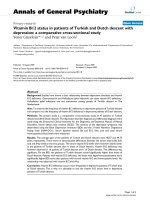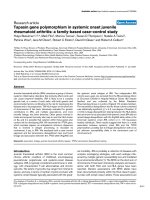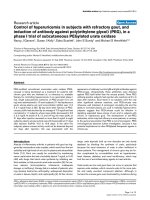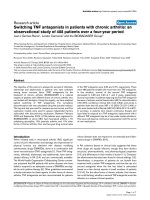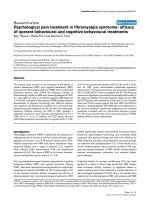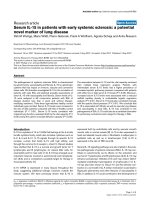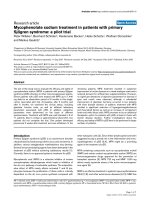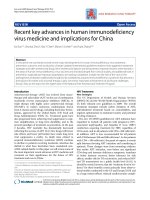Báo cáo y học: "Mycophenolate sodium treatment in patients with primary Sjögren syndrome: a pilot trial" potx
Bạn đang xem bản rút gọn của tài liệu. Xem và tải ngay bản đầy đủ của tài liệu tại đây (157.76 KB, 7 trang )
Open Access
Available online />Page 1 of 7
(page number not for citation purposes)
Vol 9 No 6
Research article
Mycophenolate sodium treatment in patients with primary
Sjögren syndrome: a pilot trial
Peter Willeke
1
, Bernhard Schlüter
2
, Heidemarie Becker
1
, Heiko Schotte
1
, Wolfram Domschke
1
and Markus Gaubitz
1
1
Department of Medicine B, Muenster University Hospital, Albert Schweitzer Street 33, D-48129 Muenster, Germany
2
Institute of Clinical Chemistry and Laboratory Medicine, Muenster University Hospital, Albert Schweitzer Street 33, D-48129 Muenster, Germany
Corresponding author: Peter Willeke,
Received: 20 Jul 2007 Revisions requested: 11 Sep 2007 Revisions received: 24 Sep 2007 Accepted: 6 Nov 2007 Published: 6 Nov 2007
Arthritis Research & Therapy 2007, 9:R115 (doi:10.1186/ar2322)
This article is online at: />© 2007 Willeke et al.; licensee BioMed Central Ltd.
This is an open access article distributed under the terms of the Creative Commons Attribution License ( />),
which permits unrestricted use, distribution, and reproduction in any medium, provided the original work is properly cited.
Abstract
The aim of this study was to evaluate the efficacy and safety of
mycophenolate sodium (MPS) in patients with primary Sjögren
syndrome (pSS) refractory to other immunosuppressive agents.
Eleven patients with pSS were treated with MPS up to 1,440
mg daily for an observation period of 6 months in this single-
center, open-label pilot trial. At baseline, after 3 months, and
after 6 months, we examined the clinical status, including
glandular function tests, as well as different laboratory
parameters associated with pSS. In addition, subjective
parameters were determined on the basis of different
questionnaires. Treatment with MPS was well tolerated in 8 of
11 patients. Due to vertigo or gastrointestinal discomfort, two
patients did not complete the trial. One patient developed
pneumonia 2 weeks after treatment and was withdrawn. In the
remaining patients, MPS treatment resulted in subjective
improvement of ocular dryness on a visual analogue scale and a
reduced demand for artificial tear supplementations. However,
no significant alterations of objective parameters for dryness of
eyes and mouth were observed, although a substantial
improvement of glandular functions occurred in two patients
with short disease duration. In addition, treatment with MPS
resulted in significant reduction of hypergammaglobulinemia
and rheumatoid factors as well as an increase of complement
levels and white blood cells. MPS promises to be an additional
therapeutic option for patients with pSS, at least in those with
shorter disease duration. Further investigations about the
efficacy and safety of MPS in pSS have to be performed in larger
numbers of patients.
Introduction
Primary Sjögren syndrome (pSS) is an autoimmune disorder
characterized by keratoconjunctivitis sicca and xerostomia. In
addition, various extraglandular manifestations may develop.
Several immunomodulating agents have been attempted in the
treatment of pSS without achieving satisfactory results [1].
Currently, there is no approved systemic treatment for pSS.
Mycophenolic acid (MPA) is a selective inhibitor of inosine
monophosphate dehydrogenase which leads to inhibition of
the de novo pathway of nucleotide synthesis. The antiprolifer-
ative effect of MPA mainly affects activated T and B lym-
phocytes because the proliferation of these cells is critically
dependent on the de novo purine synthesis compared with
other eukaryotic cells [2]. Since these lymphocytes have been
suggested to play a pivotal role in the inflammation and immu-
nopathogenesis of pSS [3,4]., MPA might be a promising
agent in the treatment of pSS.
MPA-containing compounds such as mycophenolate mofetil
(MMF) and enteric-coated mycophenolate sodium (MPS) are
immunosuppressive drugs approved for the prevention of
transplant rejection [5]. MPS 720 mg and MMF 1,000 mg
deliver nearly equimolar doses of the active immunosuppres-
sive agent [6].
MMF is an effective treatment in systemic lupus erythematosus
(SLE) [7,8]. and other autoimmune diseases [9,10]. MMF has
AE = adverse event; ESR = erythrocyte sedimentation rate; GI = gastrointestinal; Ig = immunoglobulin; MMF = mycophenolate mofetil; MPA = myc-
ophenolic acid; MPS = mycophenolate sodium; pSS = primary Sjögren syndrome; RF = rheumatoid factor; SF-36 = Short Form 36; SLE = systemic
lupus erythematosus; VAS = visual analogue scale.
Arthritis Research & Therapy Vol 9 No 6 Willeke et al.
Page 2 of 7
(page number not for citation purposes)
been used as maintenance therapy after treatment with rituxi-
mab (anti-CD20 antibody) in a patient with pSS [11]. We
reported a case of successful treatment with MMF in pSS with
vasculitis [12]. The recent observations and the
immunosuppressive effect of MPA in other autoimmune dis-
eases led us to evaluate the efficacy and safety of MPA treat-
ment in patients with pSS refractory to other
immunosuppressive agents.
Materials and methods
Study design
We performed a prospective, single-center, open-label pilot
trial for an observation period of 6 months. Medical treatment
was initiated with one tablet of 360 mg MPS per day. The dos-
age was increased weekly by 360 mg up to a maximum stable
dose of 1,440 mg daily. In patients not tolerating the drug well,
the dosage was reduced to 720 mg per day. All patients gave
written informed consent to participate. The study protocol
was approved by the local independent ethics committee.
Patient selection criteria
Inclusion and exclusion criteria for the trial are presented in
Table 1. Eligibility criteria included the diagnosis of pSS based
on the American-European Consensus criteria [13] provided
that the patients had evidence of active disease. Since there
are no validated disease activity criteria for pSS, active dis-
ease was defined by elevated erythrocyte sedimentation rate
(ESR) (>25 mm/hour), hypergammaglobulinemia (>1,500
mg/dL) and the presence of autoantibodies (that is, anti-SSA
and/or SSB antibodies and/or rheumatoid factor [RF]).
Outcome measures
Clinical visits were performed at baseline, week 12, and week
24. After 4 weeks, an additional visit, including clinical exami-
nation and laboratory tests, was performed. Patients were
asked about possible adverse events (AEs) and about the
daily demand for artificial teardrops. Clinical assessment con-
sisted of a general physical examination, the 28-joint count of
tender/swollen joints, and a tender point count (maximum of
18).
Functional parameters
The lachrymal gland function was assessed by unanesthetized
Schirmer's test [14]. A value of less than 5 mm per 5 minutes
was taken as abnormal. In addition, we collected the unstimu-
lated whole saliva throughout a 5-minute period by performing
the spitting technique [15]. A flow rate of less than 0.5 grams
per 5 minutes was considered as glandular hypofunction.
Subjective parameters
Patients were instructed to express the severity of ocular dry-
ness, arthralgia, and fatigue on a 100-mm visual analogue
scale (VAS) ranging from 0 for no symptoms to 100 for
extreme symptoms. Outcome was also determined by the
Short Form 36 (SF-36) questionnaire in eight scales (physical
functioning, role physical, bodily pain, general health, vitality,
social functioning, role emotional, and mental health) ranging
from 0 to 100 [16]. A higher value indicates a higher state of
well-being. Aggregated physical component summary score
and mental component summary score of the SF-36 were cal-
culated. The SF-36 has been validated for patients with pSS
Table 1
Inclusion and exclusion criteria
Inclusion criteria Diagnosis of primary Sjögren syndrome based on the American-European Consensus criteria [13]
Erythrocyte sedimentation rate of greater than 25 mm/hour and hypergammaglobulinemia (>1,500 mg/dL)
Presence of anti-SSA and/or SSB antibodies and/or rheumatoid factor
Requirement of artificial teardrops due to symptomatic sicca syndrome
Inadequate response or intolerance of prior treatment with hydroxychloroquine and/or azathioprine
Adequate contraception for females of childbearing potential
Exclusion criteria Age below 18 or above 75 years
Secondary Sjögren syndrome
History of cancer, severe infections, or other uncontrolled diseases
Treatment with concomitant disease-modifying antirheumatic drugs within the last 8 weeks before baseline evaluation
Prednisolone dose of greater than 5 mg/day or changes of prednisolone dose within the last 4 weeks before baseline
Use of secretagogues (for example, pilocarpine and civemeline) or medications that potentially diminish exocrine gland function
(for example, tricyclic antidepressants and anticholinergic drugs)
Pregnant or lactating women
Available online />Page 3 of 7
(page number not for citation purposes)
[17]. In addition, the Health Assessment Questionnaire was
completed by our patients [18]. Values range from 0 to 3. A
lower score indicates better health.
Laboratory parameters
Routine laboratory parameters (that is, ESR, C-reactive pro-
tein, renal and liver function tests, total protein, and full blood
count) were determined at each visit. Levels of immunoglobu-
lins (IgG, IgM, and IgA), IgM-RF, and serum concentrations of
complement levels (C3 and C4) were measured by nephelom-
etry (BN2; Dade Behring, now Siemens Medical Solutions
Diagnostics GmbH, Bad Nauheim, Germany). IgG antibodies
to SSA and SSB were analyzed by fluorescence enzyme
immunoassay (Phadia GmbH, Freiburg, Germany). Protein
electrophoresis was performed on an Olympus Hite 320
(Olympus-Diagnostika GmbH, Rees, Germany).
Statistical analysis
Data were analyzed by means of the statistic software pack-
age SPSS 12.0 (SPSS Inc., Chicago, IL, USA). The signifi-
cance of changes from baseline was measured by Wilcoxon
test. A p value of less than 0.05 was considered significant.
Results
Clinical characteristics of patients
Eleven patients with active pSS were included in this study
(Table 2). All patients were women with a mean age of 50.1 ±
10.8 years and a mean disease duration of 9.5 ± 5.4 years. All
patients had an abnormal Schirmer's test. In six patients, a
diminished salivary flow rate was detected. Seven patients had
mild leukopenia (<4,000/μL) at baseline evaluation (Table 2).
As for other extraglandular manifestations, eight patients had
arthralgia, five had Raynaud syndrome, one patient had
polyneuropathy, and one had vasculitis.
Safety of mycophenolate sodium
Eight patients completed the study period of 24 weeks. Two
patients were unwilling to continue the study after week 4 due
to vertigo (patient 1) and gastrointestinal (GI) complaints
(patient 3). Patient 6 was withdrawn at day 15 after developing
pneumonia that caused hospitalization. The patient fully recov-
ered after antibiotic treatment. This event was the only serious
AE. The reported AEs possibly related to the study medication
were of mild intensity. GI discomfort (defined by the occur-
rence of nausea, dyspepsia, or diarrhea) was the most fre-
quent AE in 4 of the 11 patients included (Table 2). These
patients had no previous evidence of intestinal involvement
associated with the disease. In one patient, a herpes labialis
infection occurred and was controlled by local application of
aciclovir. Two patients during the study developed a common
cold that required no additional medical treatment. MPS was
reduced in patients 5 and 10 after week 12 due to mild GI dis-
comfort and palpitation, respectively, which resolved after a
dose reduction of MPS. We observed no significant changes
in body weight, blood pressure, or heart rate. Also, no drug-
related hematological abnormalities were observed.
Changes in outcome parameters
Outcome parameters were evaluated for the eight patients
who completed the study (Table 3). No significant changes in
the Schirmer's test or the amount of unstimulated whole saliva
in the cohort were observed. However, in patients 8 and 11,
who had a relatively short disease duration, a significant
improvement was observed in both the Schirmer's test (1.25
Table 2
Clinical characteristics of patients
Patient Age in years Gender Disease duration
in years
Anti-SSA/Anti-
SSB/RF
Extraglandular
manifestations
Prednisolone
(mg/day)
Adverse events
1
a
59 Female 13 +/+/+ Arthralgia - Vertigo, perspiration
2 46 Female 12 +/+/+ LP, RS - GI discomfort, common cold
3
a
50 Female 15 +/+/+ Arthralgia, RS,
LP
-GI discomfort
4 67 Female 17 +/+/+ Arthralgia, RS 2.5 None
5 60 Female 4 +/+/+ Arthralgia, LP,
VA
-GI discomfort
b
6
a
61 Female 5 +/+/+ Arthralgia, LP - Pneumonia
7 53 Female 13 +/-/+ LP, PNP 2.5 GI discomfort, herpes labialis
8 40 Female 2 +/-/- Arthralgia, LP - None
9 35 Female 12 +/-/+ LP, RS 5 None
10 44 Female 9 +/+/+ Arthralgia, RS - Palpitation, perspiration
b
11 36 Female 2 +/+/- Arthralgia - Common cold
a
Patients 1, 3, and 6 did not complete the study;
b
dose was reduced to 720 mg/day after week 12. GI, gastrointestinal; LP, leukopenia; PNP,
polyneuropathy; RF, rheumatoid factor; RS, Raynaud syndrome; VA, vasculitis.
Arthritis Research & Therapy Vol 9 No 6 Willeke et al.
Page 4 of 7
(page number not for citation purposes)
± 0.35 mm at baseline versus 6.75 ± 5.3 mm after 24 weeks)
and the unstimulated whole saliva (0.17 ± 0.22 grams per 5
minutes at baseline versus 0.44 ± 0.11 grams per 5 minutes
at week 24).
No changes in the 28-swollen/tender joint count or in the
number of tender points were observed (data not shown). In
one patient with vasculitis, a remarkable improvement of the
vasculitis of the lower arms and legs was observed after 12
weeks (patient 5). This improvement lasted throughout the
study. No significant changes concerning the Raynaud syn-
drome were observed, although an angiologic examination
was not performed as follow-up procedure.
Subjective parameters
Significant improvement in patients' assessment of ocular dry-
ness on a VAS was observed (p < 0.05). The demand for daily
artificial tear supplementation decreased significantly during
treatment (p < 0.02). No significant improvement in the other
VAS was observed.
Patients had significant improvement in the general health and
the role emotional domains of the SF-36 (Figure 1). Other
domains and the physical component summary score did not
improve significantly. Although a clear tendency toward
improvement of the mental component summary score was
observed, statistical significance was not reached (p = 0.06).
Laboratory parameters
We detected a significant reduction of gamma globulins after
12 and 24 weeks of treatment with MPS (p < 0.05). Also, a
significant reduction of IgM was observed after 12 and 24
weeks, whereas the reduction of IgG or IgA was not signifi-
cant. No significant change in ESR was measured. A signifi-
cant increase of both C3 and C4 complement levels occurred
during the treatment. We further detected a decrease of IgM-
RF after 24 weeks. The white blood cell count increased sig-
nificantly from 4,478 ± 1,190 cells per microliter at baseline to
5,703 ± 1,508 cells per microliter after 24 weeks (p < 0.05)
(data not shown). No differences were found in red blood
count, thrombocytes, or renal or liver function parameters.
Table 3
Baseline values and changes in efficacy parameters
Parameter Baseline Week 12 Week 24
Glandular function tests
Schirmer's test (millimeters per 5 minutes) 2.0 ± 3.2 3.4 ± 3.5 4.4 ± 4.9
Whole saliva (grams per 5 minutes) 0.49 ± 0.41 0.48 ± 0.41 0.56 ± 0.41
Laboratory tests
Erythrocyte sedimentation rate (mm/hour) 47.6 ± 20.5 44.1 ± 23.3 44.2 ± 21.0
Gamma globulins (g/L) 21.3 ± 6.3 19.5 ± 8.6
a
18.8 ± 7.5
b
IgG (mg/dL) 2,159 ± 949 2,048 ± 755 2,025 ± 895
IgM (mg/dL) 189 ± 108 144 ± 62.7
a
142 ± 62.8
a
IgA (mg/dL) 399 ± 417 359 ± 363 329 ± 305
Rheumatoid factor IgM (IU/mL) 275 ± 504 193 ± 380 179 ± 317
a
Anti-SSA antibodies (U/mL) 5,863 ± 5,321 6,308 ± 4,008 5,892 ± 8,859
Anti-SSB antibodies (U/mL) 1,217 ± 1,386 1,424 ± 1,925 1,320 ± 1,668
C3 (mg/dL) 99.3 ± 30.2 101 ± 33.5 108 ± 34.7
b
C4 (mg/dL) 14.9 ± 8.8 16.4 ± 9.5
a
16.8 ± 8.9
b
Subjective findings
VAS sicca syndrome (0 to 100 mm) 68.7 ± 15.6 56.4 ± 19.9 52.8 ± 20.8
a
VAS arthralgia (0 to 100 mm) 62.1 ± 23.4 45.1 ± 34.3 47.5 ± 30.0
VAS fatigue (0 to 100 mm) 63.4 ± 24.0 57.4 ± 33.4 65.3 ± 22.6
Use of artificial teardrops (times per day) 3.7 ± 2.3 1.8 ± 1.3
a
1.6 ± 1.9
b
Health Assessment Questionnaire score 0.73 ± 0.77 0.81 ± 0.84 0.73 ± 0.80
a
p < 0.05 versus baseline value analyzed by Wilcoxon signed rank test;
b
p < 0.02 versus baseline value analyzed by Wilcoxon signed rank test.
Table presents outcome parameters in the eight patients with primary Sjögren syndrome who completed the study. Data are presented as mean ±
standard deviation. Ig, immunoglobulin; VAS, visual analogue scale.
Available online />Page 5 of 7
(page number not for citation purposes)
Discussion
We present the first controlled pilot trial of MPS treatment in
patients with pSS. Our study shows that MPS can improve
symptoms and laboratory findings in patients with active pSS.
The optimum systemic treatment of pSS is still unclear.
Although no controlled study has been performed so far, MPA
was suggested as sole or adjuvant treatment for pSS in a
recent review [19].
We found a significant reduction of ocular dryness assessed
by a VAS. In accordance with this finding, the daily demand for
artificial teardrops decreased significantly in our patients. On
the other hand, no improvement in the salivary and lachrymal
gland functions in our cohort was observed. It should be
noted, however, that we observed a remarkable improvement
of glandular function in two patients with a disease duration of
less than 3 years, possibly due to recovery of the glandular tis-
sue. It has been reported that regeneration of glandular tissue
and recovery of glandular function can occur only in patients
with residual glandular function [20]. Lack of improvement in
the other patients might be due to irreversible damage of the
glandular tissue after a long disease duration. Improvement of
salivary gland function has been reported in patients with early
pSS after treatment with rituximab, an anti-CD20 monoclonal
antibody. These observations emphasize the need for an ear-
lier and more aggressive treatment in pSS patients with short
disease duration [21].
Mycophenolate has been used in systemic vasculitis [22]. In
the one patient with vasculitis, a reduction that has been
reported previously in a pSS patient treated with MMF was
observed [12]. Thus, MPA-containing compounds might be
useful in this systemic manifestation.
We found a significant reduction of gamma globulins during
treatment. Hypergammaglobulinemia has been proposed as a
suitable target for therapy and as a primary outcome measure
for the evaluation of the pSS treatment [23]. It has been sug-
gested that reduction of B-cell hyperactivity with immunosup-
pressants might be the best prevention of lymphoproliferation
in pSS [24]. As a low level of C4 has been associated with an
increased risk of developing lymphoproliferative disease [25]
and as our data show an increase of C3 and C4 levels in
patients treated with MPS, this drug may be essentially bene-
ficial in this context.
Furthermore, we found a significant reduction of IgM after 24
weeks, whereas no substantial reduction of IgG or IgA was
detectable. In addition, a reduction of IgM-RF during the treat-
ment was observed. Treatment with rituximab has also been
accompanied by a decrease of IgM and IgM-RF in pSS
patients without changes in IgG or IgA levels [21,26].
We found no changes in anti-SSA/anti-SSB antibody titers.
These antibodies are relatively stable over time in individual
patients and thus are not suggested as an outcome measure
of disease activity [27]. Likewise, in pSS patients receiving B-
cell-depleting agents (for example, rituximab or epratuzumab),
no changes in anti-SSA and anti-SSB antibodies were
detected [26,28].
We observed an increase of leukocytes/neutrophils during
MPS treatment. Leukopenia is one of the most frequent extrag-
landular manifestations of the disease and is probably medi-
ated by antineutrophil antibodies [29]. Leukopenia in pSS has
been shown to be reversed by immunosuppressive treatment
with corticosteroids or hydroxychloroquine [29]. Our data
Figure 1
Short Form 36 (SF-36) at baseline and after 24 weeks of treatment with mycophenolate sodium in patients with primary Sjögren syndrome (n = 8)Short Form 36 (SF-36) at baseline and after 24 weeks of treatment with mycophenolate sodium in patients with primary Sjögren syndrome (n = 8).
The SF-36 domains are physical functioning (PF), role physical (RP), bodily pain (BP), general health (GH), vitality (VT), social functioning (SF), role
emotional (RE), mental health (MH), and the physical and mental component summary scores (PCS and MCS). The GH and RE domains increased
significantly (p < 0.05) after 24 weeks (*). The increase of the MCS did not reach significance (**p = 0.06).
Arthritis Research & Therapy Vol 9 No 6 Willeke et al.
Page 6 of 7
(page number not for citation purposes)
show that MPS also might be effective in treating pSS-associ-
ated leukopenia.
Patients of our cohort showed significant improvement in the
general health and role emotional domains of the SF-36. A
trend toward a significant increase of the mental component
summary score was observed. This indicates an improvement
in psychological distress, social disability due to emotional
problems, and self-related health [16].
The overall tolerability of MPS in patients with pSS was
acceptable. The most frequent AE was mild GI discomfort. GI
discomfort has been reported as the most common AE leading
to discontinuation of therapy in transplant recipients [6]. In
SLE patients treated with MMF, GI-related symptoms are com-
mon as well. The symptoms tend to be mild and can improve
with dose reduction [8]. In transplant recipients treated with
enteric-coated MPS, less severe GI AEs have been observed
as compared with MMF [30].
One of our patients, after 15 days of treatment, developed
pneumonia that caused hospitalization. Although the patient
received only a fairly low dose of 720 mg MPS per day for only
2 weeks, the event was possibly related to the study drug. All
in all, however, compared with studies with transplant recipi-
ents [6], the incidence rate of infections was low in the present
study.
Conclusion
Our findings of this open-label pilot trial in patients with pSS
suggest that MPS might improve subjective glandular and ext-
raglandular manifestations as well as some laboratory param-
eters. MPS promises to be an additional therapeutic option in
patients with pSS, particularly in those with early disease.
Controlled studies including larger numbers of patients with
shorter disease durations are necessary to assess more com-
prehensively the efficacy and safety of MPS in pSS.
Competing interests
The authors declare that they have no competing interests.
Authors' contributions
PW participated in the data analysis and in the design of the
study and drafted the manuscript. MG, HS, and HB helped
with data collection, patient recruitment, and the design of the
study and helped to edit the manuscript. WD helped to edit
the manuscript. BS participated in the design and helped in
the statistical analysis. All authors read and approved the final
manuscript.
Acknowledgements
This study was financially supported, in part, by Novartis Pharma GmbH
(Nürnberg, Germany).
References
1. Tomiak C, Dorner T: Sjogren's syndrome: current aspects from
a rheumatological point of view. Z Rheumatol 2006,
65:505-519.
2. Allison AC, Eugui EM: Mycophenolate mofetil and its mecha-
nisms of action. Immunopharmacology 2000, 47:85-118.
3. Hansen A, Lipsky PE, Dörner T: B cells in Sjögren's syndrome:
indications for disturbed selection and differentiation in
ectopic lymphoid tissue. Arthritis Res Ther 2007, 6:218.
4. Pers JO, Devauchelle V, Daridon C, Bendaoud B, Berre RL, Bor-
dron A, Hutin P, Renaudineau Y, Dueymes M, Loisel S, et al.:
BAFF-modulated repopulation of B lymphocytes in the blood
and salivary glands of Rituximab-treated patients with
Sjogren's syndrome. Arthritis Rheum 2007, 56:1464-1477.
5. Placebo-controlled study of mycophenolate mofetil combined
with cyclosporin and corticosteroids for prevention of acute
rejection. European Mycophenolate Mofetil Cooperative Study
Group. Lancet 1995, 345:1321-1325.
6. Pietruck F, Abbud-Filho M, Vathsala A, Massari PU, Po-Huang L,
Nashan B: Conversion from mycophenolate mofetil to enteric-
coated mycophenolate sodium in stable maintenance renal
transplant patients: pooled results from three international,
multicenter studies. Transplant Proc 2007, 39:103-108.
7. Gaubitz M, Schorat A, Schotte H, Kern P, Domschke W: Myco-
phenolate mofetil for the treatment of systemic lupus ery-
thematosus: an open pilot trial. Lupus 1999, 8:731-736.
8. Ginzler EM, Dooley MA, Aranow C, Kim MY, Buyon J, Merrill JT,
Petri M, Gilkeson GS, Wallace DJ, Weisman MH, et al.: Mycophe-
nolate mofetil or intravenous cyclophosphamide for lupus
nephritis. N Engl J Med 2005, 353:2219-2228.
9. Schneider-Gold C, Hartung HP, Gold R: Mycophenolate mofetil
and tacrolimus: new therapeutic options in neuroimmunolog-
ical diseases. Muscle Nerve 2006, 34:284-291.
10. Appel GB, Radhakrishnan J, Ginzler EM: Use of mycophenolate
mofetil in autoimmune and renal diseases. Transplantation
2005, 80:S265-S271.
11. Ahmadi-Simab K, Lamprecht P, Nolle B, Ai M, Gross WL: Suc-
cessful treatment of refractory anterior scleritis in primary
Sjogren's syndrome with rituximab. Ann Rheum Dis 2005,
64:1087-1088.
12. Willeke P, Domschke W, Gaubitz M: Mycophenolate Mofetil for
the treatment of primary Sjögren's Syndrome: a case report.
Ann Rheum Dis 2003, 62(Suppl 1):352.
13. Vitali C, Bombardieri S, Jonsson R, Moutsopoulos HM, Alexander
EL, Carsons SE, Daniels TE, Fox PC, Fox RI, Kassan SS, et al.:
Classification criteria for Sjogren's syndrome: a revised ver-
sion of the European criteria proposed by the American-Euro-
pean Consensus Group. Ann Rheum Dis 2002, 61:554-558.
14. Kallarackal GU, Ansari EA, Amos N, Martin JC, Lane C, Camilleri
JP: A comparative study to assess the clinical use of Fluores-
cein Meniscus Time (FMT) with Tear Break up Time (TBUT)
and Schirmer's tests (ST) in the diagnosis of dry eyes. Eye
2002, 16:594-600.
15. Navazesh M, Christensen CM: A comparison of whole mouth
resting and stimulated salivary measurement procedures. J
Dent Res 1982, 61:1158-1162.
16. Ware JE Jr, Sherbourne CD: The MOS 36-item short-form
health survey (SF-36). I. Conceptual framework and item
selection. Med Care 1992, 30:473-483.
17. Strombeck B, Ekdahl C, Manthorpe R, Wikstrom I, Jacobsson L:
Health-related quality of life in primary Sjogren's syndrome,
rheumatoid arthritis and fibromyalgia compared to normal
population data using SF-36. Scand J Rheumatol 2000,
29:20-28.
18. Fries JF, Spitz P, Kraines RG, Holman HR: Measurement of
patient outcome in arthritis. Arthritis Rheum 1980, 23:137-145.
19. Mavragani CP, Moutsopoulos NM, Moutsopoulos HM: The man-
agement of Sjogren's syndrome. Nat Clin Pract Rheumatol
2006, 2:252-261.
20. Pijpe J, van Imhoff GW, Vissink A, van der Wal JE, Kluin PM, Spijk-
ervet FK, Kallenberg CG, Bootsma H: Changes in salivary gland
immunohistology and function after rituximab monotherapy in
a patient with Sjogren's syndrome and associated MALT
lymphoma. Ann Rheum Dis 2005, 64:958-960.
21. Pijpe J, van Imhoff GW, Spijkervet FK, Roodenburg JL, Wolbink
GJ, Mansour K, Vissink A, Kallenberg CG, Bootsma H: Rituximab
Available online />Page 7 of 7
(page number not for citation purposes)
treatment in patients with primary Sjogren's syndrome: an
open-label phase II study. Arthritis Rheum 2005,
52:2740-2750.
22. Iaccarino L, Rampudda M, Canova M, Della Libera S, Doria A: Myc-
ophenolate mofetil: what is its place in the treatment of
autoimmune rheumatic diseases? Autoimmun Rev 190 2007,
6:190-195.
23. Asmussen KH, Bowman SJ: Outcome measures in Sjogren's
syndrome. Rheumatology (Oxford) 2001, 40:1085-1088.
24. Mariette X: Lymphomas complicating Sjogren's syndrome and
hepatitis C virus infection may share a common pathogenesis:
chronic stimulation of rheumatoid factor B cells. Ann Rheum
Dis 2001, 60:1007-1010.
25. Theander E, Henriksson G, Ljungberg O, Mandl T, Manthorpe R,
Jacobsson LT: Lymphoma and other malignancies in primary
Sjogren's syndrome: a cohort study on cancer incidence and
lymphoma predictors. Ann Rheum Dis 2006, 65:796-803.
26. Devauchelle-Pensec V, Pennec Y, Morvan J, Pers JO, Daridon C,
Jousse-Joulin S, Roudaut A, Jamin C, Renaudineau Y, Roue IQ, et
al.: Improvement of Sjogren's syndrome after two infusions of
rituximab (anti-CD20). Arthritis Rheum 2007, 57:310-317.
27. Bowman SJ, Pillemer S, Jonsson R, Asmussen K, Vitali C, Man-
thorpe R, Sutcliffe N: Revisiting Sjogren's syndrome in the new
millennium: perspectives on assessment and outcome meas-
ures. Report of a workshop held on 23 March 2000 at Oxford,
UK. Rheumatology (Oxford) 2001, 40:1180-1188.
28. Steinfeld SD, Tant L, Burmester GR, Teoh NK, Wegener WA,
Goldenberg DM, Pradier O: Epratuzumab (humanised anti-
CD22 antibody) in primary Sjogren's syndrome: an open-label
phase I/II study. Arthritis Res Ther 2006, 8:R129.
29. Schattner A, Friedman J, Klepfish A, Berrebi A: Immune cytope-
nias as the presenting finding in primary Sjogren's syndrome.
QJM 2000, 93:825-829.
30. Granger DK: Enteric-coated mycophenolate sodium: results of
two pivotal global multicenter trials. Transplant Proc 2001,
33:3241-3244.

